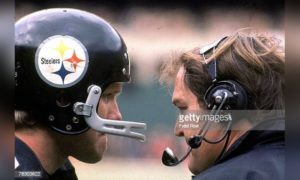If Joe Greene and Ernie Stautner are the litmus test by which jersey numbers are measured, then it’s probably not smart money to place your bets on seeing the Pittsburgh Steelers retiring any more numbers in the near future.
2014 marks the 45th year since Greene was drafted at the top of the class by a then floundering Steelers football franchise, who, along with new head coach Chuck Noll, slowly but surely turned bottom-feeder into apex predator by the mid-70s.
This year also marks the 33rd since he last played, and the 28th since he was enshrined in the Pro Football Hall of Fame. That’s how long it took for the organization to retire the number of the foundation of one of the greatest dynasties in sports history.
Why did it take so long? As chairman Dan Rooney pointed out, it had been considered for a number of years, but the same question always arose; quite simply, at what point do you stop? Especially considering offseason rosters have 90 players to account for.
It’s a little easier to retire numbers in baseball or hockey or basketball, which have much smaller rosters. Therefore, in a way, to get your number retired in the NFL almost means a bit more than in other sports, if only because of the practical implications involved in excising a number from the jersey rotation.
Greene is one of very few people in this league to have six Super Bowl rings: four as a player and two as part of the Steelers’ personnel department. His involvement with the franchise has spanned nearly half a century. It’s more common to see a Joe Greene jersey than not in Heinz Field these days, even if more than three decades have passed since he last played.
“I’m overwhelmed with emotions for sure”, he said. “That was my first thought. I was just very, very surprised and I almost fell out of my seat. My number, along with Terry [Bradshaw] and Franco [Harris] and Jack’s [Lambert], were taken out of commission. I’m definitely honored”.
He continued, explaining that learning his number would be retired was “right there” with bringing championships to the city of Pittsburgh:
It’s right there. They are all joined together but it’s right there and because it’s Pittsburgh. Retiring jerseys is not something that the Steelers do (often). That makes it even more significant. I have never seen a championship banner at our stadium. We have won more Super Bowls than anybody at this point in the history of the National Football League and we don’t flaunt it. Winning is a statement and it stands alone. That, to me, and the idea about this organization and the philosophy (when they) say we are going to retire this number that’s extremely special to me because it’s not something that they do. I’m extremely, extremely happy and excited about it. I’m overwhelmed.
As Dan Rooney described him, Greene “was the cornerstone of the Steel Curtain”. It’s just highly unfortunate that he is the last representative of that formative Steel Curtain to enjoy this moment. Both Ernie Holmes and Dwight White passed on in 2008, and L.C. Greenwood was lost last year. Noll passed away at the age of 82 earlier this year, as did Bill Nunn.
With so many crucial pieces of the most vital era of Pittsburgh’s sports history fading from view, perhaps it was the right time to enshrine the centerpiece, and the face, of that entire period. It was the right time—and maybe even the last time, for a while at least—to celebrate the legacy of that era with the ultimate honor of retiring a number and ensuring that no Steeler would ever wear it again on the field.
And, of course, it couldn’t have been anyone but Mean Joe.







